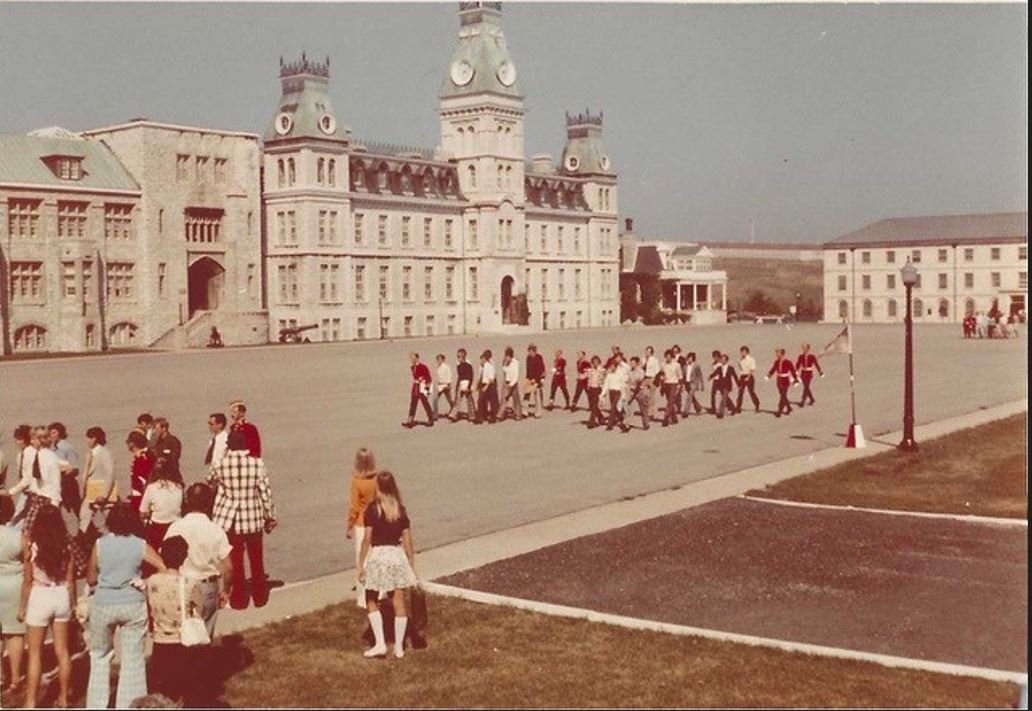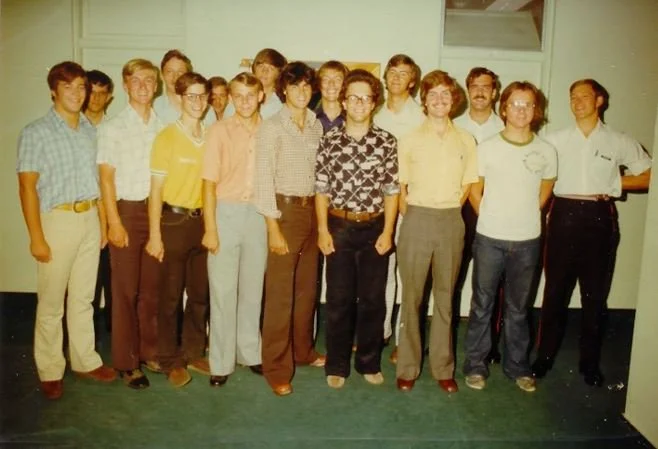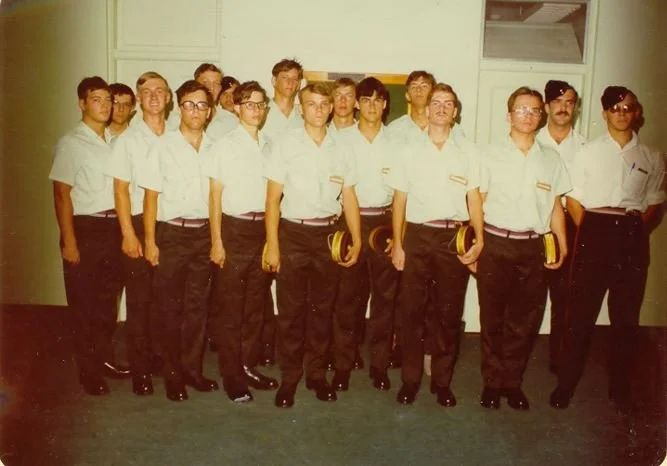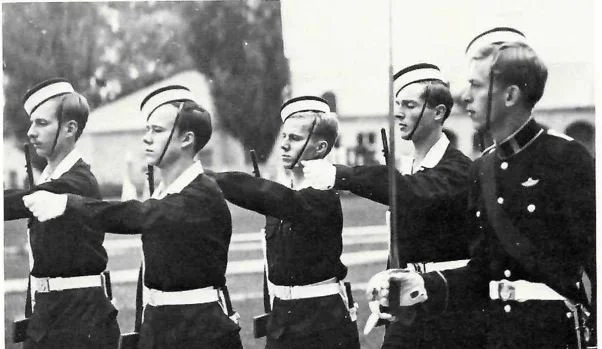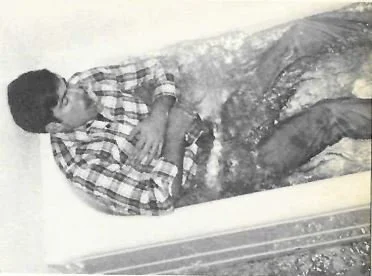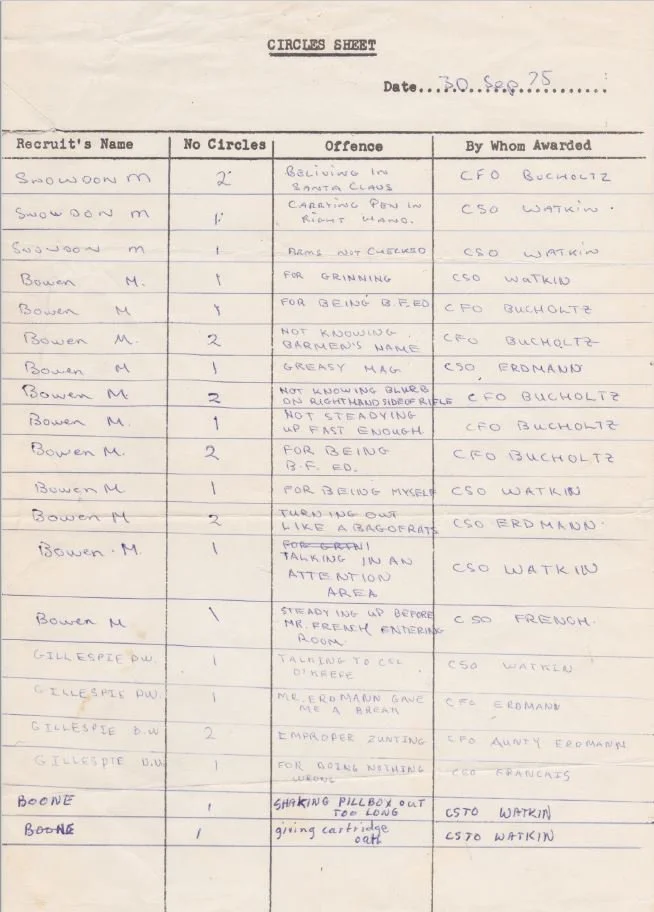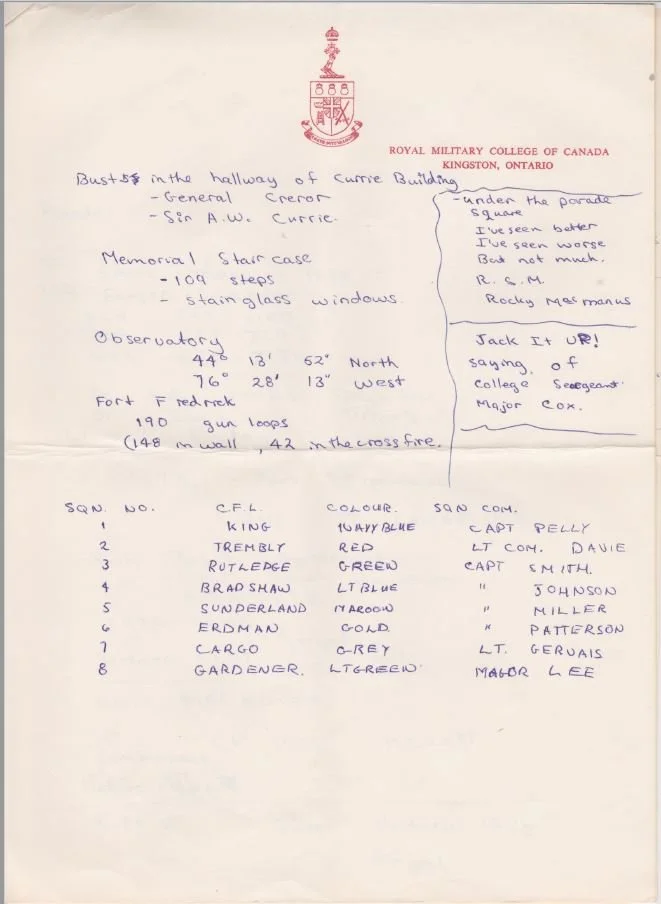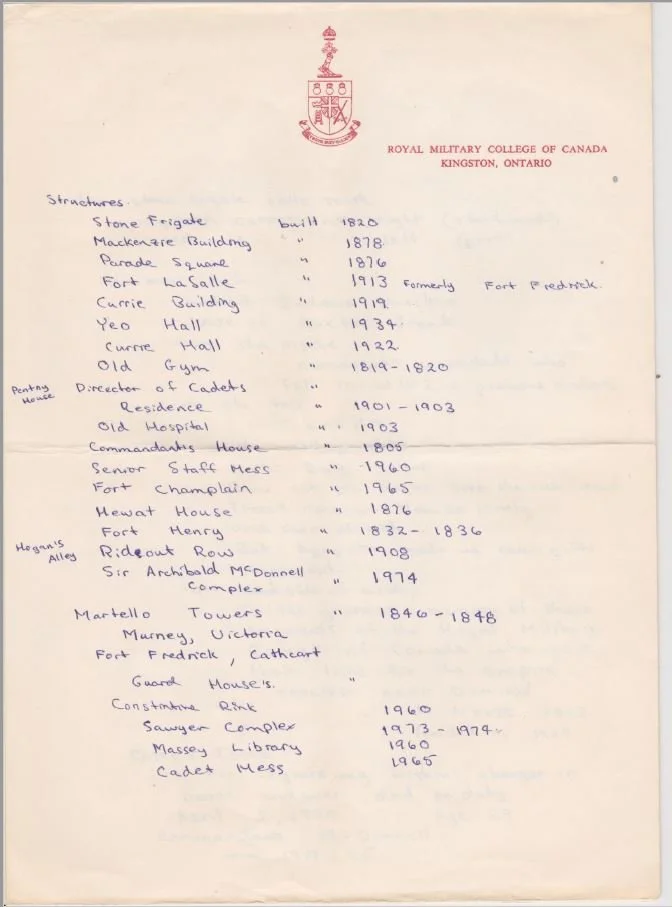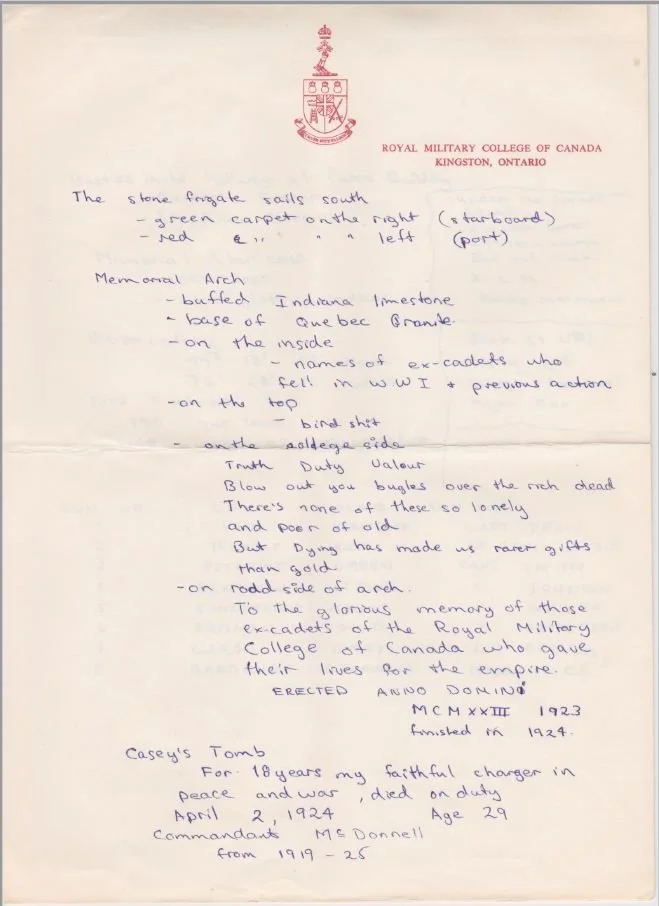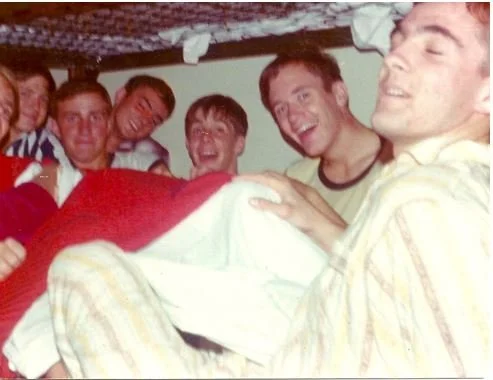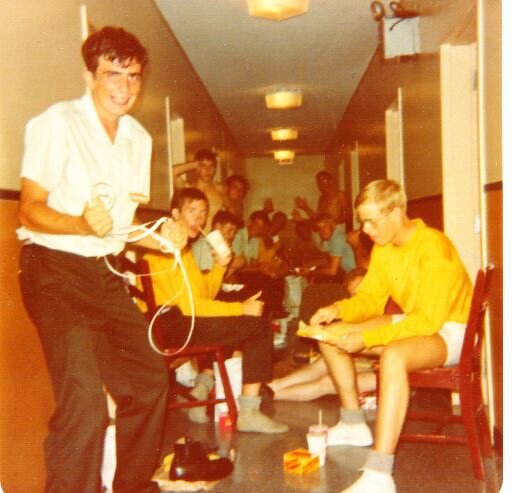Arrival
It was the 10th day of August in 1975 - a bright, sunny day in Kingston, with a slight breeze coming in from the lake and towards the parade square where everyone had gathered. Among those assembled were quite a few family members and girl friends of the young teenagers hoping to make their mark at RMC. The guys, who had come from all across Canada, wore a variety of civilian attire, appropriately reflecting the fashions of the day. Shirts and jackets had oversized lapels; pants were often a gaudy type of plaid and flared into bell bottoms; and although not pervasive, some had even donned the “trendy” platform shoes. Those wearing glasses had mostly opted for the thick oversized ones that seemed to be popular around that time. While a few had cut their hair in anticipation of what was to come, the majority had actually kept their flowing locks. The atmosphere was a combination of excitement (the adventure kind), and apprehension. Excitement soon gave way to much more serious things when those assembled heard the distinctive sound of marching in the distance. Turning around, they caught sight of a group of College seniors heading towards them in precise formation and clad in their distinctive scarlet uniforms, pill boxes, white belts, gaiters and highly shone boots. They halted smartly on the parade square, divided up in an orderly manner and began barking out names of those who were going to be in their respective recruit flights. No smiles crossed their faces. They were all business, although inwardly we suspect they were quite pleased to see so many still with long hair, knowing these baby-faced teenagers were in for a rude awakening in the very near future, not the least of which would be quite a significant transformation of their outward physical appearance.
Unfortunately, some of the recruits from Down East missed this opening ceremony entirely because their 707 service flight from Nova Scotia was delayed and as a result landed in Trenton late. After gathering their belongings, they were taken by bus to RMC and arrived just as the families were leaving the campus. They missed all the pleasantries and even the rudimentary marching lessons, and instead got there just in time to get down to business.
craig wood looking a little overwhelmed - what have I gotten myself in to!!
4 Sqn K Flight, with civvie dress for the time including bell bottom pants and wide lapels. Oh, and shocker, long hair as well
5 Sqn N Flight marching off after the visitation. the “best” was yet to come …
before - 2 sqn d flight - 12 aug 75. note all the smiles!
after - 15 aug 75 - quite a different demeanour as reality hits them! dwight is the only one still smiling, but he had been in cadets, so this was kind of old hat for him
Marching and Drill
Arms swung shoulder height and in step as well! 3 sqn g flight - ed karkut, russ parker, terry wood and glen mackay, led by csto pat sweetnam
Since cadets were required to march at all times while outdoors on the campus, and first years likewise while indoors in the hallways, plenty of time was devoted to this endeavour during the initial training phase. Now, it is true that a number of the recruits had previously been members of various Cadet organizations, so all this came quite easily to them, less so for the complete newcomers. It was not necessarily that the marching by itself was hard, more so that a recruit flight typically consisted of cadets of varying heights and body sizes which naturally could affect the gait or pace of a given cadet. A tall cadet, for example, with a long stride would have to adjust that pace to the shorter stride of the smaller members of the group, which, when factoring in say fatigue and inattention could easily lead to “zunting” or at worst the “graunching” the boot or shoe of the cadet in front of him. That split second lapse meant that the injured party was going to have to spend most of his precious little down time repairing the damage. It was quite amazing then to watch how effective that inadvertent harm to someone’s highly shone footwear could be in convincing the offending recruit to learn to march properly post haste, even more so than all the hours on the parade square.
Zunting - Most civilians or members before they joined never consciously notice that the natural walking gait of a human has the left arm and right leg moving forward at the same time, followed by the right arm and the left leg and so on. Zunting involves the left arm and left leg moving forward at the same time and then the right arm and right leg, kind of like a waddling penguin. Because it is an unnatural movement, it is actually pretty hard to do, even intentionally. However, it was not that unusual to see recruits ending up zunting, especially when trying to get back in step with the rest of the flight. This is because the natural tendency of a recruit, panicking that he is getting out of step, is to try to force his arms to match the swinging arms of the others, but without adjusting his legs at the same time.
Doubling - Any time the recruits were dressed in their PT gear, they were required to “double” everywhere - no walking or even marching was allowed, at least not outdoors. “Doubling” involved jogging at one and a half times the normal 120 step marching pace. If the Flight needed to go somewhere or was undertaking a morning fitness run, they also doubled together under the direction of the senior in charge. That senior would sometimes break into a musical cadence like one of those starting with “I don’t know, but I’ve been told” and then later get the whole group to repeat the various stanzas in unison. That really was good for morale, and also helped pass the time. However, unbeknownst to some among them, the cadence actually served another purpose, that of helping to keep everyone in step. When the first verse starts, their left feet should be touching the ground at the same time, followed by their right feet, all in unison. Later, as the recruit camp progressed, one of the recruits would be put in charge and at some point, invariably would summon up their courage and enthusiastically begin the doubling cadence with the former reason in mind but would soon learn that the latter reason was equally as important! That is because inevitably a train wreck would ensue because starting the cadence out on the wrong foot would totally confuse the Flight, causing them to fall out of step and into disarray. But, lesson learned! After a little more experience, that became instinctive and soon the focus was less on keeping in step and more on making up new and humorous stanzas in the cadence, especially if by doing so they could take a good natured jab at a nearby doubling Recruit Flight or even an unsuspecting senior or member of the military staff who happened to be within earshot. Given the location of the Cmdt’s residence, often the recruit flights, in the early hours in the morning, would let him know that they were alive and well by chanting the cadence in extra loud voices. They were hoping to roust him out of bed, but the truth of the matter is that in all likelihood the Cmdt was actually quite thrilled with their enthusiasm.
Room and Dress Inspections
It is probably safe to say that many of the guys coming to RMC had never used an iron before or folded their clothes or neatly arranged their closet or clothes drawers. Indeed, even doing something as simple as using a washing machine or dryer was completely foreign to them. All that changed quickly after their arrival. Civilian clothes were soon stored away and uniforms, shoes, rifles and bed linen/fire blankets issued, followed by detailed instructions on how to press the pants and shirts, to polish the shoes, to the clean rifles and to make the beds. As was often the case, those instructions sometimes took a long time to sink in, so inspections were held every morning, faults identified and follow-up inspections held again in the early evening. Of course, the creases and the shine on shoes or boots did not last given the hectic pace of Recruit Camp, topped off by some circles late at night, so many of the cadets would be forced to find a stealthy way to complete those essential activities after Lights Out. The other tricky part was the fact most of the guys had been assigned roommates, so failing inspection in the morning meant both had to turn out for the evening inspections regardless of who passed or failed. While seemingly unfair, most understood the logic, that of teaching the recruits they would need to work together to get through this.
larry baba using some down time to spit-polish his boots
Interestingly, like the recruits, seniors came in many shapes and sizes and temperaments, so each one had a different way of approaching things including inspections. However, ultimately the idea was to teach the recruits how to look after themselves; how to organize their affairs; how to manage their time; and importantly, how to follow orders or instructions. And yes, all those lessons could be taught without needing to yell, or to rip a “pit” apart or do those other unnecessary things you often see when inspections are portrayed in movies or on TV. Certainly, it was important that the senior be firm and leave no doubt as to what was required, but the commentary outlining faults could be vividly descriptive or succinct or even humorous, as long as the message was received and corrective action taken. Everyone quickly learned what “fraust” (lint), or “train tracks” (side-by-side creases) or “Irish pennants” (green thread sticking a uniform button or epaulette or elsewhere) meant, and that they were to be avoided.
In regards to laundry, while these former civilians might have worn the same shirt or jeans for a couple of days during high school, such was not the case at the College. To make matters worse, there were only a couple of washers and dryers on each floor, but they were used by the rest of the Squadron as well. There was simply no time available to wait, so the laundry bags had to be left in line in the laundry room, meaning it was up to others to put a new load in the washer or dryer whenever the time came. Other than a ton of wrinkles, the recruits had no idea what to expect when they went to pick up their laundry, or even if all their articles of clothing would still be there. It was not unusual for some items to go missing or be mixed up with someone else’s stuff. Dry cleaning was available for shirts and pants, but even assuming there was time to drop off at the far end of the parade square, the cleaners were not as particular about creases, often leaving “train tracks” where a single crease was the desired outcome!
Physical Fitness
fort henry and heartbreak hill
As one of the four pillars of RMC, obviously there was considerable attention paid to improving or maintaining the fitness of the recruits. For many, though, fitness was not a huge issue since certainly their physical activities before they joined was an important consideration in their selection in the first instance. Nevertheless, every opportunity was taken to make sure one and all were in shape, starting with that dreaded early morning run at “O-dark-thirty”. Recruits would form up outside their barracks, warm up and then “double” in formation in whatever direction the senior in charge saw fit, but always ending with a run around Fort Henry and back. The paved road up to the Fort was about a half a mile from bottom to top and up a pretty decent incline, followed by a flat portion behind the fort and then down towards the water where road ended and became just a narrow grassy path. Heartbeats increased immediately at that point, not because of the running but in anticipation of the upcoming, and infamous, “heartbreak” hill - a 200 yard dash in single file up a steep rise to another narrow path just below the exterior walls of the Fort. That portion was both exhausting and exhilarating at the same time, the latter because everyone knew the run was literally “downhill” from there.
While “downhill” always had a nice ring to it, given the chance to catch your breath, ironically sometimes that could be the most trying part of the run, for a couple of reasons. First and foremost, until our physical therapist Patty Clayton forced a change, we were required to wear those awful issue sneakers, aptly nicknamed the “CF Cripplers”. They were made of canvas and provided no arch support at all and had just a very thin sole so they were terrible on the shins on a slope or hard surface. Second, you actually need to control your landing feet even more running downhill, but if you are exhausted that is obviously difficult so you often end up slamming your foot even harder into the pavement which, especially in the CF Cripplers, made the repetitive impacts even worse. Patty was alarmed by the number of resulting shin splint cases arising from those runs and from playing sports on the hard floor at the new SAM complex and got the College authorities to agree to allow the use of much better quality civilian sneakers, and thank goodness for that! Those CF Cripplers also became the poster boy for cost-driven procurement practices but that is another story …
Running in formation was very important for fostering the cohesiveness of the group. Working together and supporting one another would be critical to their success. Stragglers would be cheered on to keep pace, or even escorted all the way back if needed and musical cadences sung to keep spirits up. No one wanted to let the group down. That said, towards the end of the morning run, the seniors would often let the “rabbits” take off for a sprint to the parade square, especially those who ran cross-country or competed in track and field. Those morning runs stood the new cadets in good stead for when they ran the Recruit Harriers at the end of the recruit camp and later the Wing Harriers, where the first years certainly held their own.
Like the other three pillars, cadet fitness was regularly evaluated, so it was no surprise that the recruits were tested early on as well. There were five different tests - sit ups; chin ups, an agility run; a standing broad jump, and a mile and a half run. As mentioned, most of the recruits were already in pretty good shape, but not many of their individual sports necessarily prepared them to do well in all five tests. For example, playing hockey would not necessarily help much with chin ups or say the broad jump. However, since most of the guys were already very competitive, the majority actual found the tests quite fun and interesting the first couple of times, even if they did reveal some areas that needed to be worked on. Another quirk of the tests was how well you did could depend on the PERI who was conducting the test and what he considered “good technique”. For example, chin-ups was one of the harder tests but some recruits quickly realized if they could just get a little swing going on the downward part that momentum could give them a bit of an assist going back up. However, a couple of the PERIs caught on to that “innovative” technique and would put an arm out to stop the downward swing so it was just up and down, which made the chin-ups more of a challenge. As well, and perhaps quite ironically, some of the guys who had the hardest time were actually quite muscular in their upper arms and had difficulty completing the downward part. They might do twenty chin-ups but sometimes could only count half them because they had difficulty fully extending their muscular arms all the way to the bottom.
Circles
Circles were “punishments” given out during Recruit Term, with each one representing a quarter-mile lap of the track located outside Yeo Hall and Fort Haldimand. A maximum of eight circles, effectively two miles, could be run at 2200 hrs on a given night . Although the intent was to correct certain faults exhibited by the recruits, and that way train them not to do something or to do something differently, in fact they were also constructive in another way, namely helping the guilty parties to stay physically fit. Because of this, it became de rigueur for some recruit flight seniors to arbitrarily award circles for non-sensical and often humorous reasons (e.g., “Believing in Santa Claus” or “Improper Zunting”). In another case, a couple of 3 Sqn recruits thought they would change things up a bit and decided to make the compulsory running of the Parade Square a little more interesting, effectively a competition. After halting at the edge, and looking respectfully in both directions for any officers to salute, they took off like a bat out of hell across the Square before finally breaking stride, and then, in unison, halting on the other end, dutifully checking again for officers and then resuming their quick march. All this to say the Wing HQ senior who happened to witness this “travesty” unfold a couple of days later awarded both parties a couple of circles each. However, when those in their Squadron checked the Circles Sheet most thought their “egregious” offence, “Doubling on the Parade Square too fast”, was actually pretty original, and so for the two recruits, the circles were quite worth the initiative.
While some of the recruits thought the offences could be creative and hilarious, and did not mind writing them down for the amusement of others, in fact it was not unheard of for a senior to suffer the consequences of being overly zealous in their arbitrary dispensing of circles. One CSC in particular soon gained a reputation of this nature so the exasperated recruits in his flight finally decided it was time for them to teach the lesson. After coming back from a downtown pub, helpfully a little “under the weather”, he immediately crashed fully clothed on top of his “pit”. He was quickly surrounded by his “minions” who threw a fire blanket over his head, and bundled him off to a room at the end of the hall. As part of their cunning plan, the tub there had already been filled with very cold water, so he was tossed unceremoniously in to that tub, and let out a huge gasp as the freezing water enveloped him. After taking a quick photograph, they departed in great haste, with doors closing left and right all the way up the hallway. Expecting the worst, they were quite surprised when they heard nothing further about the episode. It seems the message was received 5 by 5 (loud and clear) since he no longer awarded circles for completely frivolous reasons.
While most of the recruits were already used to running a lot, and actually did not initially mind the circles that much, they soon realized the real downside to having to run circles was that they coincided with the delivery of “kye”, the nightly snack prepared for each Squadron consisting of milk or orange juice and munchies like cinnamon toast or deserts left over from supper. Running circles soon paled in comparison to missing kye.
from mark bowen’s collection. as you can see, he appears to have been a favourite target of quite a few of the 6 sqn recruit flight seniors
Learning the History of RMC
It is important for students of any educational establishment to learn about the history of that institution, to give the students an appreciation of both those who came before them as well as to learn about the magnificent buildings and facilities on the campus, and in doing so to help instill a sense of pride. RMC was very proactive in this regard, requiring the recruits to pass a College history test before they could join the Wing. These lessons were even more meaningful for our Class because our first year (1975/76) actually coincided with the Centennial year of the College (1876-1976). Daily, we were constantly being bombarded with historical details about the various buildings, structures and monuments on the site as well as the people who attended or were associated with the College. To emphasize the point, we were required to memorize the names of the very first cadets, the Old Eighteen, and be able to recite them off by heart whenever so demanded. How we were ever going to find time to study the Cadet Handbook they gave us was a bit beyond me, given how unbelievably busy we were kept at all times during recruit camp, but eventually the verbal and written information sunk in. In fact, the vast majority of us managed to successfully pass those tests the first time on the 24th of September, the week before the Recruit Obstacle Course on the 1st of October which signalled the end of the recruit term.
notes from mark bowen’s collection
Down Time
For those among us who, a couple of weeks in, were having our doubts about this whole RMC thing, getting a break from the seemingly “all work and no play” routine was certainly a welcome distraction. Whether it was a relaxed hallway night with Big Mac’s or pizzas did not really matter. It was more about camaraderie and sharing of experiences, especially finding out most of the guys were having similar thoughts and concerns. Turns out one of the more popular topics was actually “Lies my recruiter told me!”. Almost everyone had a story about that, like one recruiter saying “Oh my gosh, yes you will have no problem switching to Pilot once you get there. We have a couple of openings in Infantry, so we are just going to put you down for that in the meantime”.
Being allowed a night off also showed them that their seniors were human after all. Mind you those seniors still had a method to their madness like when Bucky and Erdman of 6 Sqn decided to hold “fun” things like the recruit pit stuffing contest. The guys from R Flight are all smiles below, before the pit’s owner, Guy Killaby, suddenly realizes “Oh wait, darn, I am going to have to make my pit from scratch and iron everything again!”
Left to Right : Unknown, brian McNaughton, Mark Bowen, al Raymond, pete Killaby, ray Mackley, and steve Lowe.
shoe polish night with late night snack …

